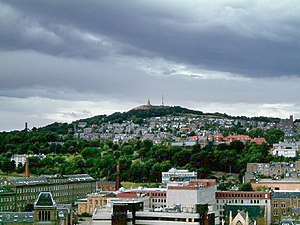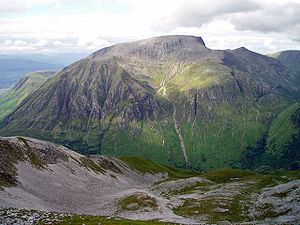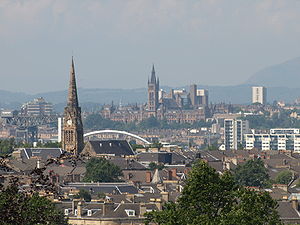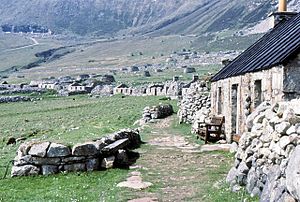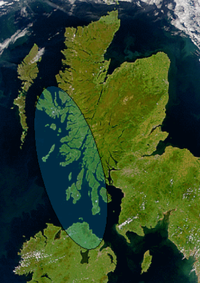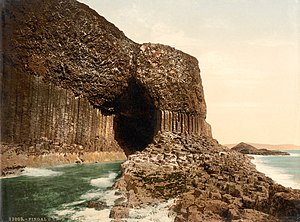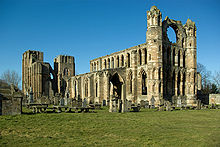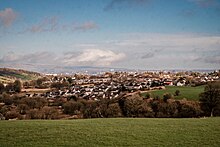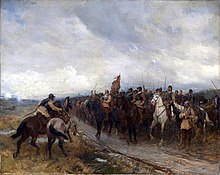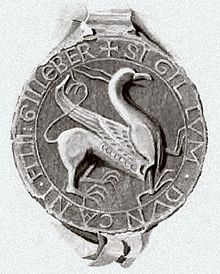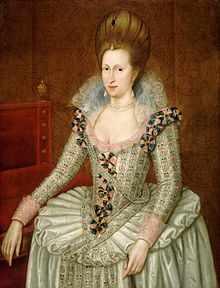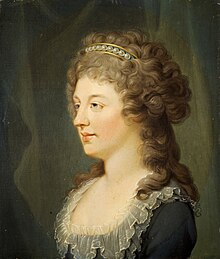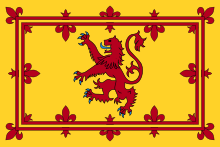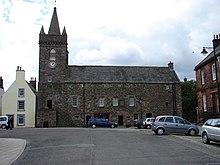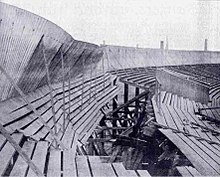User:Cactus.man/Sandbox/P-Sco/Selected articles
The Scotland Portal
| Main Page | Selected articles | Selected biographies | Selected quotes | Selected pictures | Featured Content | Categories & Topics |
Hand picked articles 1
Hand picked articles 2
Featured articles
Featured articles
"Potion" is a song by Scottish disc jockey Calvin Harris, English-Albanian singer Dua Lipa and American rapper Young Thug from Harris's sixth studio album, Funk Wav Bounces Vol. 2 (2022). The song was written by Harris, Lipa, Young Thug, Jessie Reyez and Maneesh Bidaye, with the production completed by Harris. It was released as the lead single from the album for digital download and streaming in various countries by Sony on 27 May 2022. The song combines dance, disco, EDM, and pop music to create a laidback atmosphere, accompanied by 1970s-style instrumentation of bongos, electric guitars and pianos. Its lyrics center around the essence of a potion that promises a good summer experience.
"Potion" garnered a warm reception from music critics for its music, production and Lipa and Young Thug's vocal performances. The song reached number 16 on the UK Singles Chart and achieved a silver certification from the British Phonographic Industry (BPI) in the UK. It peaked at number 31 on the Canadian Hot 100 and number 71 the US Billboard Hot 100 as well as entering the top 50 in several countries, such as Australia, New Zealand and Ireland. The psychedelic music video premiered on Harris's YouTube channel on 27 May 2022. It was designed to combine a 1960s liquid light show with a contemporary setting and displays the journey of Lipa and Young Thug stranded in a tropical island in a purple ocean. (Full article...)
"Potion" garnered a warm reception from music critics for its music, production and Lipa and Young Thug's vocal performances. The song reached number 16 on the UK Singles Chart and achieved a silver certification from the British Phonographic Industry (BPI) in the UK. It peaked at number 31 on the Canadian Hot 100 and number 71 the US Billboard Hot 100 as well as entering the top 50 in several countries, such as Australia, New Zealand and Ireland. The psychedelic music video premiered on Harris's YouTube channel on 27 May 2022. It was designed to combine a 1960s liquid light show with a contemporary setting and displays the journey of Lipa and Young Thug stranded in a tropical island in a purple ocean. (Full article...)

Scotland during the Roman Empire refers to the protohistorical period during which the Roman Empire interacted within the area of modern Scotland. Despite sporadic attempts at conquest and government between the first and fourth centuries AD, most of modern Scotland, inhabited by the Caledonians and the Maeatae, was not incorporated into the Roman Empire with Roman control over the area fluctuating.
In the Roman imperial period, the area of Caledonia lay north of the River Forth, while the area now called England was known as Britannia, the name also given to the Roman province roughly consisting of modern England and Wales and which replaced the earlier Ancient Greek designation as Albion. Roman legions arrived in the territory of modern Scotland around AD 71, having conquered the Celtic Britons of southern Britannia over the preceding three decades. Aiming to complete the Roman conquest of Britannia, the Roman armies under Quintus Petillius Cerialis and Gnaeus Julius Agricola campaigned against the Caledonians in the 70s and 80s. The Agricola, a biography of the Roman governor of Britannia by his son-in-law Tacitus mentions a Roman victory at "Mons Graupius" which became the namesake of the Grampian Mountains but whose identity has been questioned by modern scholarship. In 2023 a lost Roman road built by Julius Agricola was rediscovered in Drip close to Stirling: it has been described as "the most important road in Scottish history." (Full article...)
Dunstaffnage Castle (Scottish Gaelic: Caisteal Dhùn Stadhainis) is a partially ruined castle in Argyll and Bute, western Scotland. It lies 3 miles (5 km) NNE of Oban, situated on a platform of conglomerate rock on a promontory at the south-west of the entrance to Loch Etive, and is surrounded on three sides by the sea. The castle and the nearby chapel ruin have been a Historic Scotland property since 1958. Both are Scheduled Ancient Monuments.
The castle dates back to the 13th century, making it one of Scotland's oldest stone castles, in a local group which includes Castle Sween and Castle Tioram. Guarding a strategic location, it was built by the MacDougall lords of Lorn, and has been held since the 15th century by the Clan Campbell. To this day there is a hereditary Captain of Dunstaffnage, although they no longer reside at the castle. Dunstaffnage is maintained by Historic Environment Scotland, and is open to the public, although the 16th century gatehouse is retained as the private property of the Captain. The prefix dun in the name means "fort" in Gaelic, while the rest of the name derives from Norse stafr-nis, "headland of the staff". (Full article...)
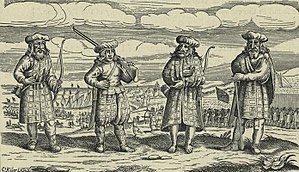
Warfare in early modern Scotland includes all forms of military activity in Scotland or by Scottish forces, between the adoption of new ideas of the Renaissance in the early sixteenth century and the military defeat of the Jacobite movement in the mid-eighteenth century.
In the late Middle Ages, Scottish armies were assembled on the basis of common service, feudal obligations and money contracts of bonds of manrent. In 1513 these systems produced a large and formidable force, but in the mid-sixteenth century there were difficulties in recruitment. Individuals were expected to provide their own equipment, including axes and pole arms. Highland troops often brought bows and two-handed swords. Heavy armour was abandoned after the Flodden campaign. Highland lords tended to continue to use lighter chainmail and ordinary highlanders dressed in the plaid. The crown took an increasing role in the supply of equipment. The pike replaced the spear and the Scots began to convert from the bow to gunpowder firearms. Feudal heavy cavalry were replaced with light horse, often drawn from the Borders. James IV established a gun foundry in 1511 and gunpowder weaponry fundamentally altered the nature of castle architecture. In the 1540s and 1550s, Scotland was given a defended border of earthwork forts and additions to existing castles. (Full article...)

Women in early modern Scotland, between the Renaissance of the early sixteenth century and the beginnings of industrialisation in the mid-eighteenth century, were part of a patriarchal society, though the enforcement of this social order was not absolute in all aspects. Women retained their family surnames at marriage and did not join their husband's kin groups. In higher social ranks, marriages were often political in nature and the subject of complex negotiations in which women as matchmakers or mothers could play a major part. Women were a major part of the workforce, with many unmarried women acting as farm servants and married women playing a part in all the major agricultural tasks, particularly during harvest. Widows could be found keeping schools, brewing ale and trading, but many at the bottom of society lived a marginal existence.
Women had limited access to formal education and girls benefited less than boys from the expansion of the parish school system. Some women were taught reading, domestic tasks, but often not writing. In noble households some received a private education and some female literary figures emerged from the seventeenth century. Religion may have been particularly important as a means of expression for women and from the seventeenth century women may have had greater opportunities for religious participation in movements outside of the established kirk. Women had very little legal status at the beginning of the period, unable to act as witnesses or legally responsible for their own actions. From the mid-sixteenth century they were increasingly criminalised, with statutes allowing them to be prosecuted for infanticide and as witches. Seventy-five per cent of an estimated 6,000 individuals prosecuted for witchcraft between 1563 and 1736 were women and perhaps 1,500 were executed. As a result, some historians have seen this period as characterised by increasing concern with women and attempts to control and constrain them. (Full article...)
Jarlshof (/ˈjɑːrlzhɒf/ YARLZ-hof) is the best-known prehistoric archaeological site in Shetland, Scotland. It lies in Sumburgh, Mainland, Shetland and has been described as "one of the most remarkable archaeological sites ever excavated in the British Isles". It contains remains dating from 2500 BC up to the 17th century AD.
The Bronze Age settlers left evidence of several small oval houses with thick stone walls and various artefacts including a decorated bone object. The Iron Age ruins include several different types of structures, including a broch and a defensive wall around the site. The Pictish period provides various works of art including a painted pebble and a symbol stone. The Viking Age ruins make up the largest such site visible anywhere in Britain and include a longhouse; excavations provided numerous tools and a detailed insight into life in Shetland at this time. The most visible structures on the site are the walls of the Scottish period fortified manor house, which inspired the name "Jarlshof" that first appears in an 1821 novel by Walter Scott. (Full article...)
The A82 is a major road in Scotland that runs from Glasgow to Inverness via Fort William. It is one of the principal north-south routes in Scotland and is mostly a trunk road managed by Transport Scotland, who view it as an important link from the Central Belt to the Scottish Highlands and beyond. The road passes close to numerous landmarks, including Loch Lomond, Rannoch Moor, Glen Coe, the Ballachulish Bridge, Ben Nevis, the Commando Memorial, Loch Ness, and Urquhart Castle. Along with the A9 and the A90 it is one of the three major north–south trunk roads connecting the Central Belt to the North.
The route is derived in several places from the military roads constructed through the Highlands by General George Wade and Major William Caulfeild in the 18th century, along with later roads constructed by Thomas Telford in the 19th. The modern route is based on that designed by Telford, but with a number of improvements primarily dating from the 1920s and 30s. These include a diversion across Rannoch Moor, and another around Loch Leven which was subsequently replaced by the Ballachulish Bridge. (Full article...)
The route is derived in several places from the military roads constructed through the Highlands by General George Wade and Major William Caulfeild in the 18th century, along with later roads constructed by Thomas Telford in the 19th. The modern route is based on that designed by Telford, but with a number of improvements primarily dating from the 1920s and 30s. These include a diversion across Rannoch Moor, and another around Loch Leven which was subsequently replaced by the Ballachulish Bridge. (Full article...)
The Daily Mash is a British satirical website providing parodic commentary on current affairs and other news stories. Neil Rafferty (a former political correspondent for The Sunday Times) and Paul Stokes (former business editor of The Scotsman), created the website in 2007 and remain the lead writers. Both writers earn salaries from the enterprise and also employ freelance contributors. The publication has garnered praise for its absurd, scatological humour and insightful political satire. The current editor is comedy writer and former BBC journalist Tim Telling. The Daily Mash has often been compared to the US publication The Onion. (Full article...)
Edzell Castle is a ruined 16th-century castle, with an early-17th-century walled garden. It is located close to Edzell, and is around 5 miles (8 km) north of Brechin, in Angus, Scotland. Edzell Castle was begun around 1520 by David Lindsay, 9th Earl of Crawford, and expanded by his son, Sir David Lindsay, Lord Edzell, who also laid out the garden in 1604. The castle saw little military action, and was, in its design, construction and use, more of a country house than a defensive structure. It was briefly occupied by English troops during Oliver Cromwell's invasion of Scotland in 1651. In 1715 it was sold by the Lindsay family, and eventually came into the ownership of the Earl of Dalhousie. It was given into state care in the 1930s, and is now a visitor attraction run by Historic Environment Scotland (open all year; entrance charge). The castle consists of the original tower house and building ranges around a courtyard. The adjacent Renaissance walled garden, incorporating intricate relief carvings, is unique in Scotland. It was replanted in the 1930s, and is considered to have links to esoteric traditions, including Rosicrucianism and Freemasonry. (Full article...)
Kirkcudbright Tolbooth is a historic municipal building in Kirkcudbright in Kirkcudbrightshire in the administrative area of Dumfries and Galloway, Scotland. Built between 1627 and 1629 to serve the town as a centre of commercial administration, a meeting place for the council, and a prison, it was used for all these roles until the late eighteenth century when the council moved much of its business to new, larger premises they had constructed across the street; the tolbooth remained in use as a prison until the early nineteenth century, after which it remained in council ownership and was put to a variety of uses.
Amongst the people incarcerated in the tolbooth during its use as a prison were people accused of witchcraft, and as late as 1805 it was used to imprison a woman convicted of pretending to be a witch. It was also used to imprison Covenanters during the Killing Time of 1679–1688; in 1684 a crowd stormed the building, killing a guard and freeing the Covenanters held within. American naval hero John Paul Jones was held in the tolbooth in 1770, following his arrest on suspicion of homicide after a sailor under his command died following a flogging Jones had ordered. (Full article...)
James Curran Baxter (29 September 1939 – 14 April 2001) was a Scottish professional footballer who played as a left half. He is generally regarded as one of the country's greatest ever players. He was born, educated and started his career in Fife, but his peak playing years were in the early 1960s with the Glasgow club Rangers, whom he helped to win ten trophies between 1960 and 1965, and where he became known as "Slim Jim". However, he started drinking heavily during a four-month layoff caused by a leg fracture in December 1964, his fitness suffered, and he was transferred to Sunderland in summer 1965. In two and a half years at Sunderland he played 98 games and scored 12 goals, becoming known for drinking himself unconscious the night before a match and playing well the next day. At the end of 1967 Sunderland transferred him to Nottingham Forest, who gave him a free transfer back to Rangers in 1969 after 50 games. After a further year with Rangers Baxter retired from football in 1970, at the age of 31.
From 1960 to 1967, he was a leading member of a strong Scottish international team that lost only once to England, in 1966, shortly after he recovered from the leg fracture. He thought his best international performance was a 2–1 win against England in 1963, when he scored both goals after Scotland were reduced to 10 players. In the 1967 match against England, who had won the 1966 World Cup, he taunted the opposition by ball juggling while waiting for his teammates to find good positions. Although he was given most of the credit for the 3–2 win, some commentators wished he had made an effort to run up a bigger score. (Full article...)
From 1960 to 1967, he was a leading member of a strong Scottish international team that lost only once to England, in 1966, shortly after he recovered from the leg fracture. He thought his best international performance was a 2–1 win against England in 1963, when he scored both goals after Scotland were reduced to 10 players. In the 1967 match against England, who had won the 1966 World Cup, he taunted the opposition by ball juggling while waiting for his teammates to find good positions. Although he was given most of the credit for the 3–2 win, some commentators wished he had made an effort to run up a bigger score. (Full article...)

Scottish art is the body of visual art made in what is now Scotland, or about Scottish subjects, since prehistoric times. It forms a distinctive tradition within European art, but the political union with England has led its partial subsumation in British art.
The earliest examples of art from what is now Scotland are highly decorated carved stone balls from the Neolithic period. From the Bronze Age there are examples of carvings, including the first representations of objects, and cup and ring marks. More extensive Scottish examples of patterned objects and gold work are found the Iron Age. Elaborately carved Pictish stones and impressive metalwork emerged in Scotland the early Middle Ages. The development of a common style of Insular art across Great Britain and Ireland influenced elaborate jewellery and illuminated manuscripts such as the Book of Kells. Only isolated examples survive of native artwork from the late Middle Ages and of works created or strongly influenced by artists of Flemish origin. The influence of the Renaissance can be seen in stone carving and painting from the fifteenth century. In the sixteenth century the crown began to employ Flemish court painters who have left a portrait record of royalty. The Reformation removed a major source of patronage for art and limited the level of public display, but may have helped in the growth of secular domestic forms, particularly elaborate painting of roofs and walls. Although the loss of the court as a result of the Union of Crowns in 1603 removed another major source of patronage, the seventeenth century saw the emergence of the first significant native artists for whom names are extant, with figures such as George Jamesone and John Michael Wright. (Full article...)
The 1902 Ibrox disaster was the collapse of a stand at Ibrox Park (now Ibrox Stadium) in Govan (now part of Glasgow), Scotland. The incident led to the deaths of 25 supporters and injuries to 500 more during an international association football match between Scotland and England on 5 April 1902 as part of the 1901–02 British Home Championship.
Ibrox Park had completed construction less than three years before the incident and was hosting its first international fixture, with the crowd estimated to be over 68,000. The match was the first time that the ground had been used at more than half capacity since its opening. Scotland entered the game needing only to avoid defeat to win the British Home Championship title. During the first half of the match, a section of the newly built West Tribune Stand collapsed, dropping between 200 and 300 people to the concrete floor below. Two spectators were declared dead at the scene, and a further twenty-three died of injuries sustained in the incident soon after, the last victim dying three weeks later. (Full article...)





